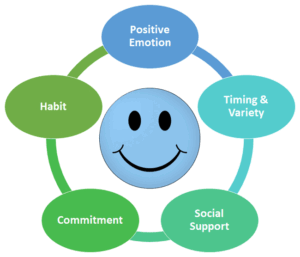“If you want to reap long term emotional benefits from a happiness activity, you need to devote persistent effort.” – Sonia Lyubomirsky
As I hearken back to the original post in this series, I land once again on the finding that 40% of our happiness level can be attributed to our intentional activity. Dr. Sonia Lyubomirsky provided 12 evidence-based strategies with which to invest intentional effort in The How of Happiness. She closes the book with five overarching practices to sustain happiness.
 Architect positive emotion. Create lots of happy moments that engender feelings of joy, delight, contentment, serenity, curiosity, interest, vitality, enthusiasm, and satisfaction. Positive emotions beget positive thinking. They encourage us to be more productive, active, healthy, friendly, helpful, resilient, and creative. They help us achieve our goals and set new ones.
Architect positive emotion. Create lots of happy moments that engender feelings of joy, delight, contentment, serenity, curiosity, interest, vitality, enthusiasm, and satisfaction. Positive emotions beget positive thinking. They encourage us to be more productive, active, healthy, friendly, helpful, resilient, and creative. They help us achieve our goals and set new ones.
The book presents an interesting hypothetical of a windfall gain of a large sum of money. Rather than blow it all on a fancy car or new home, the happier person spends it gradually over time on lots of joyful experiences. One big jolt of happiness wears off quickly. A series of happy moments creates an upward spiral of positivity.
Experiment with timing and variety. Even the best laid happiness plans can succumb to hedonic adaptation. We get used to them and fail to get the “happiness hit” that we’d like. Try spacing activities out and varying their content to keep the experience fresh. Avoid making them rote or treating them like chores. For example, count blessings once a week rather than every day. Or designate a “do-gooder” day and concentrate giving and volunteerism on that day. Shake things up periodically and see what works best.
Get social support. As Lyubomirsky says: “Any change in behavior that requires effort and dedication will be easier if spouse, children, friends, parents, siblings, coworkers are supportive.” They can work with you to remove impediments to your behavioral change. They can provide tangible support, comfort, and motivation. And they can offer feedback and encouragement. Lyubomirsky cites a 4-month weight loss experiment with two groups. Of the folks who dieted with friends, 95% completed the program and 66% kept the weight off for 6 months. Of the folks who dieted alone, 76% completed the program and only 24% kept the weight off for 6 months.
Make a commitment. A happiness program takes time and sustained effort. Participants must resolve to do it, learn the tools of the trade, do the work, and maintain a constancy of effort long term. The desire for change must be deep-seated; intrinsic motivation makes all the difference.
Make happiness a habit. I’ve read quite a few books on the power of habit. They’re forged when we inculcate a behavior in response to a specific cue or circumstance in anticipation of a reward. While it takes repetition to groove a habit, the behavior eventually becomes automatic in response to the trigger. We don’t think or decide; we just do. As such, we’d do well to go on autopilot with our versions of Lyubomirsky’s happiness strategies. We’ll reap the greatest amount of joy for the least amount of effort.